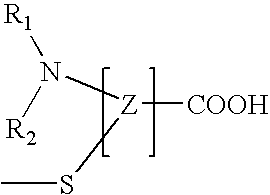Polyamide graft copolymers
a polyamide and copolymer technology, applied in the field of polyamide graft copolymer, can solve the problems of inability to intimately admix or blend, incompatible mutually, and typically "messy" procedures
- Summary
- Abstract
- Description
- Claims
- Application Information
AI Technical Summary
Problems solved by technology
Method used
Image
Examples
example 2
[0082] The polyamide graft copolymer synthesis was carried out in a solvent system originally developed by Higashi et al [J. Polym. Sci., Polym. Chem. ed., Vol. 18, pages 1711, 1841, 2875 (1980)] for the solution polymerization of high molar mass polyamides. This polymerization of diacids and diamines was run in an NMP-pyridine so-solvent mixture, in the presence of triphenyl phosphite (TPP) and LiCl. The pyridine aids in the dissolution of the amino acid reactants. Triphenyl phosphite catalyzes the polymerization by reacting with the acids and amines to remove water from the condensation. LiCl facilitates the reaction of the triphenyl phosphite.
[0083] The condensation mechanism, as proposed by Higashi, is illustrated in FIGS. 5 and 7. Triphenyl phosphite reacts with LiCl to form a triphenyl phosphonium salt (FIG. 1, Step 1). The phosphonium salt then reacts with a carboxylic acid to form a diphenyl phosphonium cation and a phenolic anion (Step 2). An amine can then attack the carbo...
PUM
| Property | Measurement | Unit |
|---|---|---|
| pKa | aaaaa | aaaaa |
| glass transition temperature | aaaaa | aaaaa |
| glass transition temperature | aaaaa | aaaaa |
Abstract
Description
Claims
Application Information
 Login to View More
Login to View More - R&D Engineer
- R&D Manager
- IP Professional
- Industry Leading Data Capabilities
- Powerful AI technology
- Patent DNA Extraction
Browse by: Latest US Patents, China's latest patents, Technical Efficacy Thesaurus, Application Domain, Technology Topic, Popular Technical Reports.
© 2024 PatSnap. All rights reserved.Legal|Privacy policy|Modern Slavery Act Transparency Statement|Sitemap|About US| Contact US: help@patsnap.com










